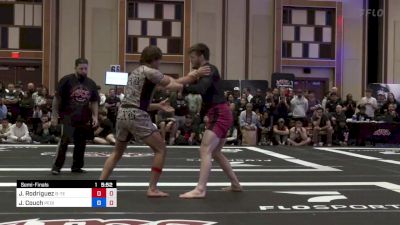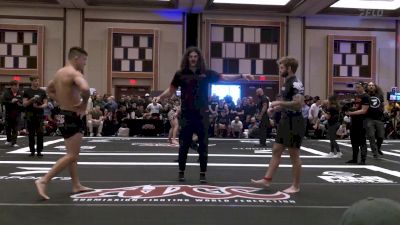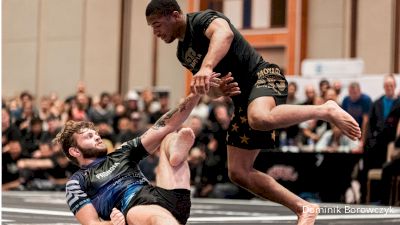6 Technical Trends From ADCC East Coast Trials
6 Technical Trends From ADCC East Coast Trials
Now that we have had a little bit of time to reflect on ADCC East Coast Trials, let's take a look at a few interesting technique trends from the event

ADCC East Coast Trials is done and we saw hundreds of matches happen across two days, with eight champions ultimately emerging. For any tournament of that size and magnitude of importance, you can begin to look across all of the matches and pick out trends that can inform what you are watching.
Submission grappling will always be a trend-driven sport. As one style finds a way to dominate, people will develop to counter and overtake that style. The game always marches on and evolves. Some of the most popular elements today will fade as moves that are much less common become a must-have for anyone who wants to compete.
In fact, many of these trends are a response to one of the most recent revolutions within the sport, the major adoption of leg locking across no-gi jiu-jitsu. Not only has leg locking itself seen an adaptation, but people who want to avoid and defend leg locks are also changing their games in noticeable, interesting ways.
Let's take a look at six of the trends we noticed at the 2023 East Coast Trials.
Straight Ankle Locks & Straight Ashi Attacks Are Back
Once the leg lock revolution hit, everyone's focus quickly turned to the most powerful submission possible - the inside heel hook. Whether from cross ashi/saddle or 50/50, we saw tons of grapplers chasing the inside heel hook as a way to overpower their opponent to a finish. Now, however, we are seeing an evolution of that original game plan.
As defenses and escapes have improved from cross ashi positions, we are seeing people moving back to the straight ashi positions - single leg X or outside ashi, for example. At Trials we saw a lot of high profile matches ending here, despite them being thought of as weaker options for many years. While these submissions may lack a little of the power that the inside heel hook carries, they are easier to get into and still strong enough to get the tap.
Another wrinkle from the straight ashi is how good leg lockers are now needing to be able to finish from the achilles lock, Aoki lock, or outside heel hook. The outside heel hook grip comes from internal rotation of the toes, the Aoki grip comes from internal rotation of the heel, and the achilles lock comes from an over-extension of the straightened foot. By following an opponent through each of these angles, it offers them more opportunities to create a dilemma that ends in a submission for them.
Now that we have had two different Trials (European & North American), we can start to contrast them and see differences. Something worth noting is how the passing styles varied between the tournaments. Largely, we saw the people at European Trials using more tight passing, like Jozef Chen's high tripod body locks, or some of the heavy pressure knee cuts that Santeri Lillius or Owen Jones were using. At East Coast Trials, those who were most successful with their passing saw it largely with loose passing, using torreandos and movement to break people down side to side. This was probably most easily evident in the championship runs of Dorian Olivarez and Elijah Dorsey, both of whom used some very slick loose passing sequences to threaten passing to either side or north south.
Why are so many going to loose passing at the most recent Trials? It's becoming more popular as a no-gi strategy lately mainly as a response to leg locking. By constantly moving side to side and keeping your legs untangled and away from your opponent, the risk of getting leg locked can drop. It also creates a kind of pressure on your opponent to constantly frame and react as you switch sides, which can be exhausting.
This isn't to say one style is inherently better or worse than the other, or that there weren't examples of many different styles across either tournament, but taken as a whole we did see a small divergence that is worth keeping an eye on.
The Wrestling Is Improving
There's no mistaking it, the overall level of wrestling is slowly but surely improving at ADCC Trials. The minutes-long pushing-pulling collar tie battles from years past were mostly gone as athletes were more confident and skilled committing to takedowns, whether shooting to the legs or attacking the upper body. More than ever, grapplers are also converting their takedowns into back exposure they can use to get behind their opponent.
That's not to say that the takedowns have reached their finish line yet. Especially once people were stood up for overtime, you saw examples of guard players who were noticeably uncomfortable having to hand fight and move on the feet for any extended period of time.
Sweeps and reversals were hard to come by at East Coast Trials, despite having some really great guard players in the field. People who were able to pull successfully were the ones able to use their guard for a submission threat, those who spent too much time hunting a sweep were largely not able to pull it off. The last few years have seen a lot of people working on wrestling up from their guard and using hook sweep/sumi gaeshi from butterfly guard, but even those weren't working well.
That could be because by the time those elite names faced off, they had been through so many rounds that sweeping and controlling a sweaty opponent was too difficult. It could be because the improved wrestling has also improved people's base and balance. It could be because of the guard players focus on leg locking submission offense. For whatever reason, if your game plan at East Coast Trials was to pull and sweep, it was a long day.
One notable position we saw some successful sweeping was half guard. We saw some people working well to dig the underhook and wrestle up or using the knee lever/giggler to catch people by surprise. We also saw a really nice sweep by Adam Bradley against NCAA wrestling champion Michael Pixley from half guard, where he used a waiter position to get on top and secure the win.
The rear naked choke will always be the most popular way to end a fight, but at Trials we saw a huge number of people scoring submissions off of the front headlock position as well. Whether it was the guillotine, darce, anaconda, or some other form of fight ending choke, clearly this has become a focus for athletes across the board.
Why are we seeing this uptick in guillotines and front headlock proficiency? The simple answer from a technical perspective would be looking at the last major trend - leg locks. As people get better at keeping their legs away from the game, they have to engage more with the upper body and that is going to leave front headlocks as the first best option.
This doesn't even consider how many front headlocks didn't end with submission, but rather led to someone going behind their opponent for a positional advantage. We mentioned earlier the way wrestling is evolving for a grappling-specific ruleset and that is clearly evident in how skillful people are getting from this singular position.
People Still Don't Know How To Game The Rules
This isn't really a technical note or trend, but rather strategic. There were many examples of experienced grapplers still not being able to successfully game the rules in ADCC to their advantage. For example, there were multiple people in the semifinals and finals who lost because a negative for pulling guard, when there is a path to legally pull (shooting to a leg for 3 seconds, then falling back).
Understanding the ADCC rules, and being able to execute to them, continues to be one of the biggest advantages an athlete can have walking into Trials. It's no coincidence that 6 of the 8 East Coast Trials champions had been active on the ADCC Open circuit.
Related Content
 Replay: Mat 2 - 2024 ADCC Phoenix Open | May 18 @ 8 AM
Replay: Mat 2 - 2024 ADCC Phoenix Open | May 18 @ 8 AMMay 19, 2024
 Replay: Mat 4 - 2024 ADCC Phoenix Open | May 18 @ 8 AM
Replay: Mat 4 - 2024 ADCC Phoenix Open | May 18 @ 8 AMMay 19, 2024
 Replay: Mat 5 - 2024 ADCC Phoenix Open | May 18 @ 8 AM
Replay: Mat 5 - 2024 ADCC Phoenix Open | May 18 @ 8 AMMay 19, 2024
 Replay: Mat 3 - 2024 ADCC Phoenix Open | May 18 @ 8 AM
Replay: Mat 3 - 2024 ADCC Phoenix Open | May 18 @ 8 AMMay 19, 2024
 Replay: Mat 8 - 2024 ADCC Phoenix Open | May 18 @ 8 AM
Replay: Mat 8 - 2024 ADCC Phoenix Open | May 18 @ 8 AMMay 19, 2024
 Replay: Mat 11 - 2024 ADCC Phoenix Open | May 18 @ 8 AM
Replay: Mat 11 - 2024 ADCC Phoenix Open | May 18 @ 8 AMMay 19, 2024
 Dax Howard vs Matthew Yee 2024 ADCC Phoenix Open
Dax Howard vs Matthew Yee 2024 ADCC Phoenix OpenMay 19, 2024
 Replay: Mat 1 - 2024 ADCC Phoenix Open | May 18 @ 8 AM
Replay: Mat 1 - 2024 ADCC Phoenix Open | May 18 @ 8 AMMay 19, 2024
 Replay: Mat 9 - 2024 ADCC Phoenix Open | May 18 @ 8 AM
Replay: Mat 9 - 2024 ADCC Phoenix Open | May 18 @ 8 AMMay 19, 2024










